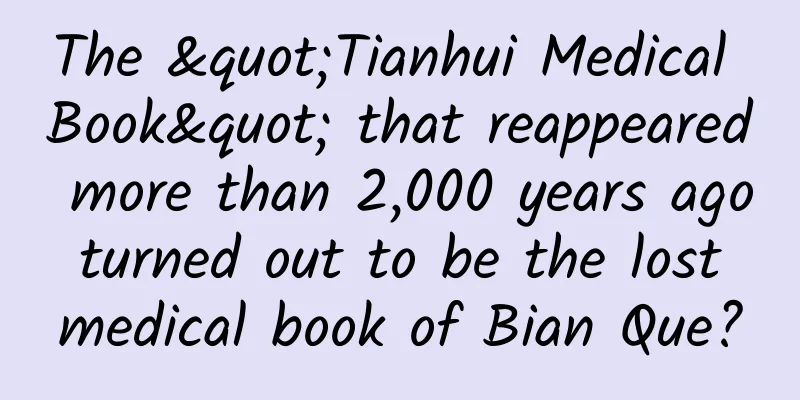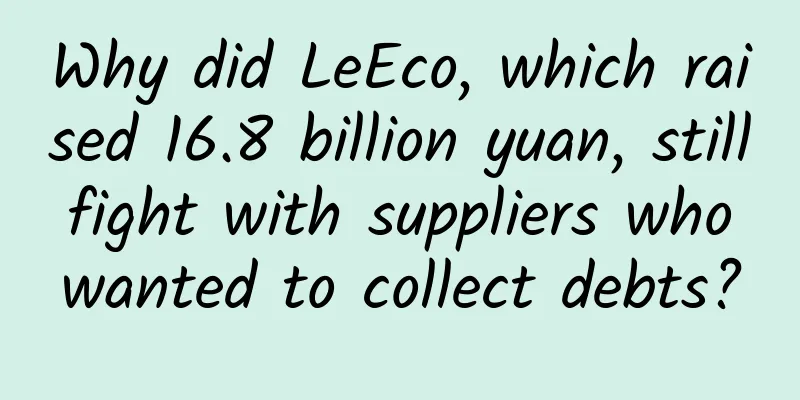The "Tianhui Medical Book" that reappeared more than 2,000 years ago turned out to be the lost medical book of Bian Que?

|
Recently, the Tianhui Medical Bamboo Slips, a Han Dynasty medical bamboo slip deciphered by cultural relics restoration experts over a ten-year period, were officially published. The contents of this batch of medical bamboo slips include traditional Chinese medicine theories, Chinese medicine preparations, Chinese medicine treatments , etc., providing extremely valuable material evidence for the source of Chinese acupuncture academic exploration. What is even more rare is that after repeated verification and in-depth research, more experts believe that it is the pioneering work of the Bian Que School and the source of the classic Chinese medicine "Huangdi Neijing". Tianhui Medical Manual is officially published (Photo by Xinhua News Agency reporter Tong Fang) A single stone stirs up a thousand waves. Following the heated discussion over the Han Dynasty medical bamboo slips unearthed in Chengdu ten years ago, the publication of the Tianhui Medical Bamboo Slips has once again attracted widespread attention from the world. Unexpected discovery sparks research boom In July 2012, during the construction of Chengdu Metro Line 3, construction workers accidentally discovered a tomb from the early Western Han Dynasty at Laoguanshan in Tianhui Town, Jinniu District. Archaeologists called it the "Laoguanshan Han Tomb." During the subsequent rescue archaeological excavation, staff discovered a pile of black bamboo slips that looked like soft noodles. Experts and scholars have made in-depth restorations based on the shape of the bamboo slips, the font of the text, and the stacking conditions, and have obtained more than 920 medical slips and 50 wooden slips, with more than 20,000 words. In addition to the human meridians, acupuncture points, and internal organs, the content also includes many medical prescriptions of the time. For example, the prescriptions for treating rheumatism and headaches are almost the same as those used by doctors today. The industry calls this batch of medical slips "Laoguanshan Medical Slips" or "Tianhui Medical Slips." The state of the Tianhui Medical Bamboo Slips when they were unearthed (Photo courtesy of Chengdu Institute of Cultural Relics and Archaeology) The Tianhui Medical Notes caused a sensation as soon as they were published. The archaeological community mainly studies its author, origin and the background of the time, and uses advanced scientific and technological means to restore and read the text. The Chinese medical community paid attention to its content and eventually compiled it into eight medical books, including "The Book of Pulse·Upper Classic", "The Book of Pulse·Lower Classic", "The Five Colors of Pulses to Test the Spirit", "The Principles of Pulse", "The Number of Acupuncture", "The Treatment of Sixty Diseases with Heqi Decoction", "The Meridians", and "The Book of Horse Treatment" (nine books were compiled initially, and the other one was "My Old Medical Theory", which were later dispersed into several other books, with "The Book of Pulse·Upper Classic" as the main one). Cultural scholars study its influence on Chinese culture and its practical significance. Over the past few years, the media has published nearly 10,000 papers and articles on the Tianhui Medical Bamboo Slips, as well as dozens of monographs on the subject. Taking the study of the Tianhui Medical Bamboo Slips as an opportunity, the Sichuan Provincial Party Committee and the Provincial Government established the Chinese Institute of Excavated Medical Documents and Cultural Relics in 2018, and appointed Liu Changhua as the dean and editor-in-chief of the Tianhui Medical Bamboo Slips. As the most complete, richest in content and most clinically valuable medical document discovered after the founding of New China, "Tianhui Yijian" provides the academic community with accurate and reliable first-hand research materials on traditional Chinese medicine. It is of great significance for enhancing the research on the cultural roots of traditional Chinese medicine and guiding clinical practice. What is most exciting is that the Tianhui Medical Bamboo Slips and the lacquered wooden figurines with human acupuncture points unearthed at the same time provide accurate physical evidence for exploring the origins of ancient acupuncture. The origin of pulse diagnosis revealed by wooden figurines of medical records After years of research, scientists represented by Liu Changhua believe that "Tianhui Yijian" is the ancestor of pulse research, hundreds of years earlier than "Maijing" (compiled by Wang Shuhe in the Western Jin Dynasty), and is also one of the main scriptures quoted in the explanation of "Huangdi Neijing". Huangdi Neijing is recognized as the earliest Chinese medical classic, one of the four classics of traditional medicine (the other three are Nanjing, Shanghan Zabing Lun and Shennong Bencao Jing), known as the "ancestor of medical books". This book was formed in the Western Han Dynasty. The content is divided into two parts, "Lingshu" and "Suwen", which contains profound wisdom on health preservation. The content of one or two sentences in Tianhui Yijian would take two or three articles to interpret in Huangdi Neijing. For example, in Pulse Book, Xiajing, two types of disease systems are described in three or five sentences. One is to classify and treat with prescriptions and medicines according to characteristics such as arthralgia and wind, and the other is to diagnose and acupuncture based on the twelve meridians. The Suwen and Lingshu, which have been handed down from generation to generation, each use an article to discuss in detail the "changes of diseases". The lacquered wooden figurines of human meridian acupoints unearthed at the same time as the medical bamboo slips are the earliest and most complete medical model of meridians discovered in my country. They are nearly 1,000 years earlier than the meridian figurines made by Wang Weiyi, a medical officer, at the request of Emperor Renzong of the Northern Song Dynasty. This upright wooden figure is about 14 cm tall, with clear facial features. There are more than 110 points and the names of related internal organs engraved on the head, limbs, abdomen, back, chest and waist. Points are called "pulse mouth", "qi mouth" or "acupoints" in traditional Chinese medicine. There is a famous "Tongtian" theory in traditional Chinese medicine, that is, the five internal organs of the human body are connected with the natural world. Acupoints are the places where the qi of the five internal organs is transported to the skin, and they are also the stimulation points for acupuncture treatment of diseases. Lacquered wooden figurines with acupuncture points on the human body (Source: Xinhua News Agency) In the past, when experts studied medical classics such as the Yellow Emperor's Classic of Internal Medicine, there was no human body model for reference, and they had unclear understanding of some acupoints, which posed certain risks during clinical acupuncture. Now, through the lacquered wooden figurines with human meridian points unearthed in Tianhui Town, some unsolved acupuncture problems can be effectively solved. From this perspective, the lacquered wooden figurines with human meridian points are the "key" to unlocking the meridian theory of traditional Chinese medicine. The lacquered wooden figurines of human acupoints and the Tianhui Medical Manual are the origins of Chinese pulse diagnosis. When it comes to Chinese medicine pulse diagnosis, there is one person who cannot be avoided, and that is Bian Que, the first Chinese medicine expert to be recorded in the official history. "To this day, the world's pulse diagnosis is due to Bian Que," Sima Qian introduced in "Records of the Grand Historian: Biographies of Bian Que and Cang Gong". Or it may be the lost medical canon of Bian Que Anyone familiar with traditional Chinese medicine knows that the medical books compiled by Bian Que have long been lost, and his medical skills are as confusing as he is, and have long been untraceable. There is controversy in the academic community as to whether Bian Que was a person or a school of thought. One school of thought believes that Bian Que, whose original name was Qin Yueren, also known as Ji Yueren, was a famous doctor in the Eastern Zhou Dynasty. Because of his superb medical skills, including surgery, internal medicine, gynecology, pediatrics, acupuncture, etc., people called him the ancient mythical bird Bian Que. Around 500 BC, he went to the State of Jin to cure the "five-day unconsciousness" of Zhao Jianzi, a minister of Jin. As a result, he became famous. Later, he went to Linzi, the capital of Qi, and observed that Duke Huan of Qi's illness gradually worsened. He tried to persuade him three times, but he refused to listen, so he had to flee to Qin alone. This incident was written into an article, but the protagonist was changed from Duke Huan of Qi to Duke Huan of Cai, titled "Bian Que Meets Duke Huan of Cai", which was selected into junior high school textbooks. Portrait of the legendary doctor Bian Que (source see watermark) Another group believes that according to historical records, Bian Que's first and last important medical practice spanned more than 200 years, so his age is not credible, and the medical skills he mastered are too comprehensive to be the work of one person. All experts believe that Bian Que was a traditional Chinese medicine organization, or something like what we call a medical institution today. This is the "Bian Que School" in traditional Chinese medicine. Regardless of whether it was one person or a group of people, the academic community recognizes that Bian Que is the founder of pulse diagnosis. It has long been a lack of physical evidence. The reason why the academic community believes that "Tianhui Medical Jian" was written by Bian Que or the Bian Que school is because the name of a person named "Bi Xi" appears many times in the book. The original text is "Bi Xi said", which is similar to "Zi Yue" in "The Analects of Confucius". According to experts' research on Shuowen Jiezi, Jingdian Shiwen, Guangyun and other reference books, Bian Que was also written as "褊鹊", and "璧" could be used interchangeably with "褊" before the early Han Dynasty. For example, the pre-Qin states called themselves "璧邑", which was a humble way of referring to a small country. For example, in Zuo Zhuan, Xianggong 31, there is a saying, "my 佰邑 is small and narrow, between big countries". The pronunciation of the character "鹊" comes from the left half "昔", and the meaning comes from the right half "鸟". The character "鹊" could be used interchangeably with "昔" before the early Han Dynasty. Therefore, "璧昔" is a synonymous homophone of "Bian Que" in the pre-Qin period. The word "Bixi" on the Tianhui Medical Slip (source see watermark) At this point, based on the profound pulse theory recorded in Tianhui Medical Notes and many clinical cases applicable to various fields of medicine, we can draw the following hypothesis: The doctor in the late Spring and Autumn Period was called "Bian Que" because of his superb medical skills and his many rescues. Due to the lack of uniformity in writing, the names "Bian Que", "Guan Que" and "Bi Xi" were used. During his medical practice, Qin Yueren wrote books and collected many disciples, thus forming the Bian Que School. It was said that in the early Han Dynasty, Bian Que from Shandong sent doctors to move from Shandong to Shuzhong with medical books, and was buried in Tianhui Town after his death. As a result, the precious classic "Tianhui Medical Records" came into being more than 2,000 years later! References: 1. "Han Tomb at Laoguanshan in Chengdu", China Cultural Relics News, December 20, 2013, Page 4, Special Edition 2. "Analysis of the "Bixi" in the New Discovery of "Bixi Medical Theory", author Du Feng, "Voice of Doctors" No. 2, 2016 3. "The Medical Records in the Han Tomb of Laoguanshan in Chengdu" is a Study on Bian Que, by Wu Jiabi, "Voice of Doctors" No. 1, 2018 4. China Traditional Chinese Medicine Journal, April 17, 2023 (first edition) Author: Wei Deyong, member of Shenzhen Writers Association, Guangdong |
<<: Do you always want to slack off at work? Scientists: Your brain needs to detox!
Recommend
World Beauty Day丨The most cost-effective "beauty" method, you may have been doing it wrong
November 7th of each year is World Beauty Day, wh...
APP promotion: How to attract a large amount of free traffic?
If marketing were a science, I would rather be a ...
Seven years after Jobs left: Apple's compromise and "betrayal"
In the post-Jobs era, Apple's market value ex...
How to draw a white polar bear on a blank piece of paper?
Everyone may have been attracted by the beautiful...
Love will leave an imprint on the brain丨Tech Weekly
Compiled by Zhou Shuyi Love leaves an imprint on ...
How far away is Betelgeuse, the famously doomed star?
How to measure the distance from Betelgeuse to Ea...
Changes in the “Living Room Strategy” of Video Sites
In the once bustling box market, all video websit...
6 data analysis tools that you must know for operations, free and practical!
Communities , official accounts, product promotio...
iPhone X has a new way to play, this time you have to play games with your eyebrows: Rainbrow
Animoji is another native feature of iPhone X tha...
If you want your product copy to speak well, first learn to cut the copy
A copywriter is a salesperson who sits behind a k...
Barrage module
Source code introduction: sliding channel selecti...
Written before the release of iOS9: The history of iOS development
Review of iOS Development History <br /> Ju...
Quantum of the Tomorrow: The most awesome photo ever
In the Southern Song Dynasty, during the Battle o...
No more breaking up! Russia agrees to extend the operation of the International Space Station
Recently, the Russian State Space Corporation ann...
How can copywriting impress 99% of users? Grasp these 3 points!
How to write copy so that people will want to buy...



![Video account sales tutorial: Teach you how to make health tea step by step, and easily earn 100,000+ yuan a month [Video course]](/upload/images/67cc3051d7fd9.webp)





